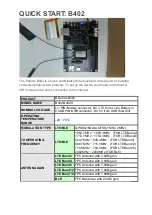
- 26 -
Specifications
Useable Frequency Range:
300 kHz to 30 MHz
The
NCC-1
is primarily designed for 500 kHz to 15 MHz use, although useful operating
range extends from below 300 kHz to above 30 MHz.
Third Order Output Intercept:
+32 dBm each Input, +38 dBm both inputs combined
Gain Flatness:
+/- 1 dB Over Complete Phase Rotation
Gain:
Adjustable from 0 dB to –40 dB
Available Phase Rotation:
>360 degrees between 500 kHz and 15 MHz
Power : NCC-1
+13.8 Vdc nominal @ 2A, well filtered & fused
Antenna Port power:
+10 to +30 Vdc @ 300 mA maximum, TX muting available
Appendix A
Every radio manufacturer's accessory interconnection scheme is different. The following are only
suggestions, and you should consult your radio manufacturer's manual for details and requirements
for receive signal inputs/outputs and switching voltages.
NCC-1 Connection Diagram for High Power Operation
Using the
NCC-1
with DX Engineering Active Receive Antennas, close spaced, and a high power
transmit amplifier.
When high power operation is desired,
Figure A1
shows the correct method of protecting DX
Engineering Active Receive Antennas from transmit energy using the optional
DXE-TVSU-1A
Time Variable Sequence Unit. The optional
TVSU-1A
is required for high power operation to
control the timing of the transceiver, amplifier,
NCC-1
and the Active Receive Antennas.
PTT
using a hand switch or foot switch is required. VOX operation on the transceiver may not be
used.
CW keying is connected directly to the
TVSU-1A
, not the transceiver. The
TVSU-1A
provides side tone in real time to prevent confusion of the delayed CW keying. Side tone from the
radio needs to be turned off.
The optional
DXE-DCPC-24
is specifically used in a DX Engineering receiving antenna phasing
system between the "PRE-AMP POWER OUT" port on the
DXE-TVSU-1A
Time Variable
Sequence Unit, and the "ANT PWR" power input on the
DXE-NCC-1
Receive Antenna Phasing
Controller. The
DXE-DCPC-24
is a 24 inch red and black stripe power cable that
features TWO 2.1 mm DC power connectors known as "barrel", "concentric" or "tip" connectors,
one at each end. This special cable is used in applications where DC power is supplied from one
device to another.
















































